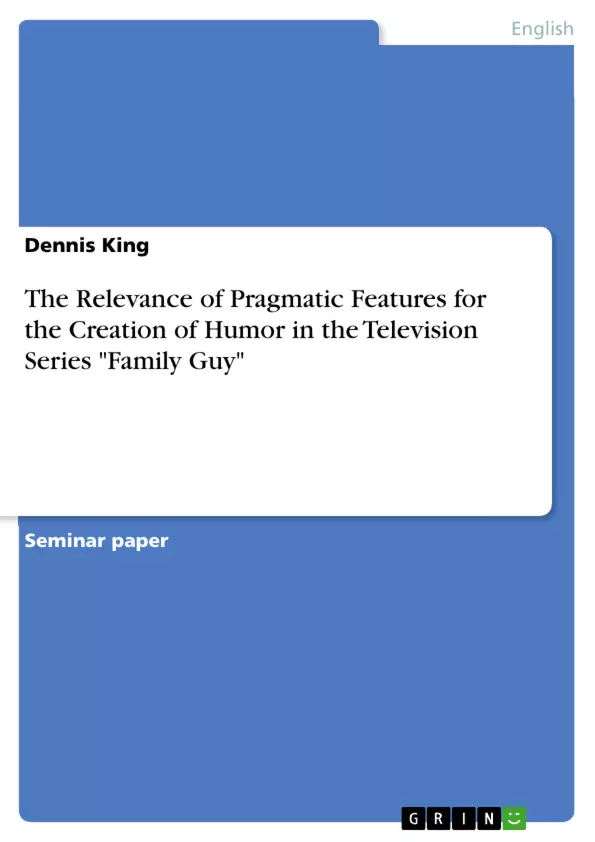In this paper, I will analyze the animated sitcom Family Guy in terms of three linguistic features and how they relate to creating humor. The sitcom is an example of (scripted) authentic English language. The paper is divided into five sections. After this introduction, I will provide relevant theoretical background knowledge. I will start by reminding the reader of the concept of pragmatics and then introduce three pragmatic theories. First, I will present Speech Act Theory with its differentiation of the locutionary act, the illocutionary act and perlocutionary act as well as the differentiation between direct and indirect speech acts. Second, I will depict the Cooperative Principle with its four maxims (quantity, quality, relation and manner), the four types of non-observance of these maxims (flouting, violating, opting out and infringing) and the notion of implicature. Third, I will introduce the concept of politeness including positive and negative face and the idea of face-threatening acts that need to be compensated by politeness strategies.
In section three, I will present Family Guy and its characters and state why using a sitcom is beneficial for my analysis. In section four, I will present and analyze eleven excerpts from various episodes in terms of the creation of humor based on pragmatic features. I will end this paper with a conclusion, in which I will present thirteen ‘humor formulas’ that I was able to deduce from the analysis.
Inhaltsverzeichnis (Table of Contents)
- Introduction
- Theoretical background
- Speech Act Theory (SAT)
- The Cooperative Principle (CP)
- Brown and Levinson's model of politeness
- Language material
- Analysis
- Conclusion
- References
Zielsetzung und Themenschwerpunkte (Objectives and Key Themes)
This paper examines the use of pragmatic features in the creation of humor in the animated sitcom Family Guy. The author aims to analyze how specific linguistic features contribute to the show's comedic style. The paper focuses on the relevance of Speech Act Theory, the Cooperative Principle, and politeness theory in understanding the humorous effects in Family Guy.
- The role of speech acts in generating humor
- The application of the Cooperative Principle and its maxims in comedic scenarios
- The significance of politeness theory in understanding humor related to face-threatening acts
- The analysis of specific excerpts from Family Guy episodes to illustrate the interplay of pragmatic features and humor
- The identification of recurring humor formulas based on pragmatic analysis
Zusammenfassung der Kapitel (Chapter Summaries)
- Introduction: This chapter provides a brief overview of the paper's focus and structure. It outlines the three pragmatic features that will be analyzed and emphasizes the sitcom's authenticity in representing English language usage.
- Theoretical background: This chapter defines pragmatics and introduces three key theories: Speech Act Theory, the Cooperative Principle, and politeness theory. It explains the concepts of locutionary, illocutionary, and perlocutionary acts within Speech Act Theory, and describes the maxims and types of non-observance within the Cooperative Principle. It also introduces Brown and Levinson's model of politeness, including the concepts of positive and negative face and face-threatening acts.
- Language material: This chapter will likely present a detailed description of the chosen sitcom, Family Guy, including its characters and its suitability as a case study for analyzing pragmatic features in humor.
- Analysis: This chapter will present and analyze a selection of eleven excerpts from different Family Guy episodes. The analysis will focus on how the chosen pragmatic features contribute to the humorous effects in each excerpt.
Schlüsselwörter (Keywords)
This paper focuses on the key concepts of pragmatics, humor, and discourse analysis. It explores the relevance of specific pragmatic features, including Speech Act Theory, the Cooperative Principle, and politeness theory, in understanding how humor is generated in the animated sitcom Family Guy. Key terms include speech acts, illocutionary force, implicature, face, face-threatening acts, and politeness strategies.
- Citation du texte
- Dennis King (Auteur), 2017, The Relevance of Pragmatic Features for the Creation of Humor in the Television Series "Family Guy", Munich, GRIN Verlag, https://www.grin.com/document/414068



